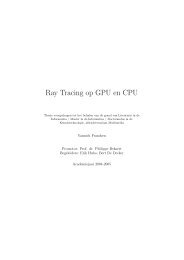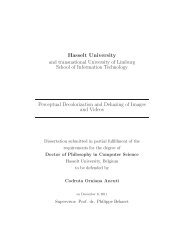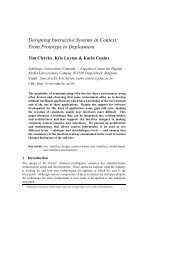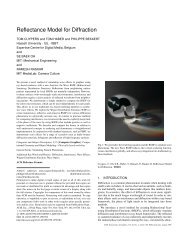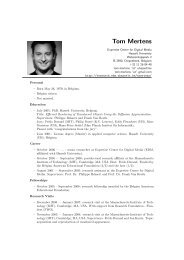DOCTORAATSPROEFSCHRIFT - EDM - UHasselt
DOCTORAATSPROEFSCHRIFT - EDM - UHasselt
DOCTORAATSPROEFSCHRIFT - EDM - UHasselt
Create successful ePaper yourself
Turn your PDF publications into a flip-book with our unique Google optimized e-Paper software.
2.1 NVE systems 29<br />
Figure 2.2: Maniac Mansion (1988). The interface is partially graphical and<br />
partially text-based, point-and-click.<br />
Software Engineering (CASE), concurrent engineering, workflow management,<br />
distance learning, telemedicine, . . . .<br />
Also in that period, the US military started to interconnect several of its<br />
single-user VR simulations in order to allow training with human allies and<br />
opponents. The SIMNET [Miller 95] project resulted in a standard that is<br />
still being used today, DIS (Distributed Interactive Simulation). A few years<br />
later, non-military NVEs started to appear. Some of the most important include:<br />
NPSNET [Macedonia 95], DIVE (Distributed Interactive Virtual Environment<br />
[Hagsand 96]) and MASSIVE (Model, Architecture and System for<br />
Spatial Interaction in Virtual Environments [Greenhalgh 95]). NPSNET, was<br />
one of the first systems that although it was based on the DIS system, was<br />
designed for the Internet, using IP multicast to inform clients of updates. Furthermore,<br />
it was one of the first systems that deployed Area Of Interest (AOI)<br />
management, in order to decrease the number of updates that needed to be<br />
sent. DIVE on the other hand, aimed at dedicated networks by employing<br />
full broadcast for all updates that needed to be sent, and all clients held a full<br />
state of the entire virtual world. It differs from similar approaches in its dynamic<br />
and flexible capabilities and its focus on interaction and human-human



